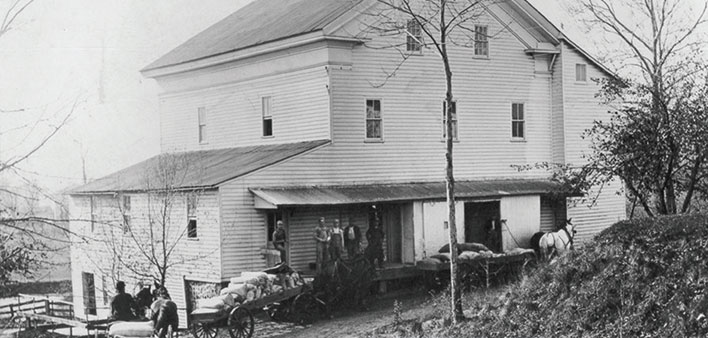Water Power at the Mill – 1878

By Denis LeDuc
In the early 1800s much of Macomb County was thickly forested wilderness; but by the 1840s, what had been the frontier, was yielding to the axe, plough, and the relentless push of the pioneers westward. Log cabins were giving way to more comfortable frame homes. Farming communities were in need of the blacksmith, barrel cooper, general store, and a grist mill to process their corn and wheat into meal and fl our.
By the end of the 1840s, the population of Ray Township had grown to 1,200 farmers and tradesmen. It was in this peaceful and tranquil community setting that Arad Freeman built his water -powered mill on the North Branch of the Clinton River fl owing through Ray Township. The mill, first known as the Monterey Mill and then the Ocean Mill, was serving the farmers of Ray Township by the end of 1847.
The Freeman family successfully ran the mill until after the Civil War. At that time the mill began to fall on hard times since Ray Township was bypassed by the railroad. In 1878 the mill was sold to Frederick Wolcott who improved and expanded the mill and updated its machinery.
Frederick Wolcott had led an adventurous life. At 17, during the Civil War, he ran his family’s saw mill in Pennsylvania. When his father went off to fight for the Union Army, he learned the saw mill business as well as became an accomplished carpenter. In 1865, after his father’s return from the war, Fred traveled west to Nebraska, then Wyoming, Utah, and California.
Fred began to work as a bridge builder for the Central Pacific Railroad as it pushed east from California to link with the Union Pacific Railroad coming westward to create the first transcontinental railroad.
Fred was present when the railroads met and the final “golden spike” was driven at Promontory, Utah on May 10, 1869. Fred returned to Nebraska in March 1870 to join his family, which had migrated there from Pennsylvania. He homesteaded land in Nebraska, married Anna Callahan and started his family.
After enduring nine years of storms, drought, floods, and locusts, Fred traded his tract of Nebraska land for the mill in Ray Township and renamed it the Wolcott Mill.
Fred expanded and modernized the mill. Under the Wolcott name, the mill remained in business well into the 20th century. Although it continued to use water power, electricity was added in the 1920’s as well as more efficient steel roller machinery. The flour from the Wolcott Mill was considered to be of very high quality and the mill supplied several important commercial bakeries in Detroit.
Our photo above shows the loading dock of Wolcott Mill about 1920. If you look carefully at the bottom of the picture, there are three horse drawn wagons, and the center wagon is loaded with sacks of fl our. It is late fall and all the leaves have fallen from the trees.
The mill continued to operate until 1967 when it was sold. The Huron-Clinton Metropark Authority acquired the mill in 1979 as an historic interpretive site. It is now the centerpiece of the Wolcott Mill Metropark. It is amongst the oldest preserved mills in Michigan and was placed on the National Register of Historic Places by the National Park Service in 2009.
When you visit the mill, you will see the preserved original machinery.
For more information, visit metroparks.com. Photo, circa 1920, courtesy of the Wolcott Mill Metropark

